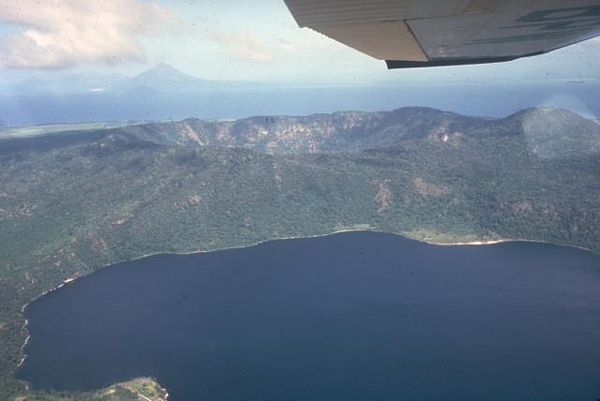
Other ITA web sites:

Apoyeque Volcano, Nicaragua
The Apoyeque volcanic complex occupies the broad Chiltepe Peninsula, which extends into south-central Lake Managua.
The peninsula is part of the Chiltepe pyroclastic shield volcano, one of three large ignimbrite shields on the Nicaraguan volcanic front.
A 2.8-kilometer wide, 400-m-deep, lake-filled caldera whose floor lies near sea level truncates the low Apoyeque volcano, which rises only about 500 m above the lake shore.
The caldera was the source of a thick mantle of dacitic pumice that blankets the surrounding area.
The 2.5 x 3 kilometer wide lake-filled Xiloa (Jiloa) maar, is located immediately SE of Apoyeque.
The Talpetatl lava dome was constructed between Laguna Xiloa and Lake Managua.
Pumiceous pyroclastic flows from Laguna Xiloa were erupted about 6100 years ago and overlie deposits of comparable age from the Masaya plinian eruption.
Apoyeque stratovolcano forms the large Chiltepe Peninsula in central Lake Managua.
A 2.8-km wide, 500-m-deep caldera truncates the volcano's summit, below and to the left of the airplane wing.
Laguna de Jiloa, the large lake in the foreground, lies immediately SE of Apoyeque.
The age of the latest eruption of Apoyeque is not known, but human footprints underlie pumice deposits thought to originate from Apoyeque volcano or a nearby vent beneath Lake Managua.
Momotombo volcano is visible in the distance to the NW across Lake Managua.

The summit caldera of Apoyeque volcano is filled by a scenic lake.
The age of the latest eruption of Apoyeque is not known, but human footprints underlie pumice deposits thought to originate from Apoyeque volcano or a nearby vent beneath Lake Managua.
This view is from the west caldera rim with the Chiltepe Hills in the background.

The forested Apoyeque stratovolcano is truncated by a 2.8-km-wide lake-filled caldera, seen here from the west.
Another lake-filled caldera, Laguna de Jiloa, is located immediately to the SE.

The deep blue Laguna de Jiloa (left) and the turquoise-colored Laguna Apoyeque dramatically fill two calderas on the Chiltepe Peninsula north of Managua.
The 2.8-km-wide Apoyeque caldera, the source of the major Chiltepe Pumice about 2000 years ago, has a more circular outline than the scalloped 2.5 x 3 km wide Jiloa caldera, which was the site of a major explosive eruption about 6500 years ago.

The SE shore of Laguna de Jiloa is the site of tourist resorts that are popular destinations from the nearby capital city of Managua.
The Chiltepe Hills on the horizon beyond the caldera rim to the north are the high points of the Chiltepe Peninsula.

Laguna de Apoyeque fills a 2.8-km-wide caldera constructed at the center of the Chiltepe Peninsula.
The caldera rim rises about 400 m above the lake, whose surface lies only about 40 m above sea level.
Two major pumice deposits erupted about 18,000-25,000 years ago originated from Apoyeque caldera.
The Lower Apoyeque pumice was erupted about 22,000-25,000 years ago, while the Upper Apoyeque pumice, which forms a distinctive layer in the Managua area, was erupted a few thousand years later.
Lake Managua lies at the upper right.

The broad Chiltepe Peninsula rises to the SE across the flood-stained waters of Lake Managua.
Apoyeque caldera lies beyond its horizontal rim on the right-center horizon.
The 11-km-wide peninsula extends into Lake Managua and marks the northern limit of a segment of the central Nicaraguan volcanic chain that is offset to the east.

The Chiltepe Peninsula is seen across Lake Managua from the south on the outskirts of the city of Managua.
The broad peninsula extends into the lake about 6 km north of the city and lies at the northern end of a chain of pyroclastic cones and craters that extends into the city.
The small conical peak on the far right horizon is Volcán Chiltepe.

Two lake-filled calderas dominate the 11-km-wide Chiltepe Peninsula extending NE-ward into Lake Managua.
Greenish Lake Apoyeque was the source of two major late-Pleistocene plinian pumice deposits, and dark-blue Lake Jiloa (Xiloa) produced the Jiloa Pumice about 6500 years ago.
The two calderas cut the summit of the Chiltepe pyroclastic shield volcano.
Nicaragua's capital city Managua, extending across much of the right side of the image, has been subjected to major tectonic earthquakes.

Laguna de Jiloa was the source of a major explosive eruption about 6500 years ago that deposited the widespread Jiloa Pumice, which blankets the Managua area.
Laguna de Jiloa (also spelled Xiloa) is seen here in an aerial view from the north with Lake Managua at the upper left.
The rim of the 2.5-km-wide caldera is lowest on the SE (left) and rises to 220 m on the NW side.
Cones of the Nejapa-Miraflores alignment can be seen extending to the south from the center of the far caldera rim.

An archaeological site at Acahualinca near Managua exposes human footprints that were covered by voluminous pumice-fall deposits from Apoyeque volcano.
The footprints are older than the overlying ca. 6500 yrs Before Present (BP) Jiloa Pumice and may occur within a ca. 7500 yrs BP mudflow deposit from Masaya volcano and thus range between about 6500 and 7500 yrs BP.
These renowned footprints are the oldest indication of human habitation in the Managua area.
PHOTO SOURCES: Jaime Incer, 1975-1996, Alain Creusset-Eon, 1970 (courtesy of Jaime Incer), Lee Siebert, 1998 (Smithsonian Institution), NASA 2002, courtesy of the Global Volcanism Program, Smithsonian National Museum of Natural History, used with permission.
NOTE: The information regarding Volcano on this page is re-published from other sources. No claims are made regarding the accuracy of Volcano information contained here. All suggestions for corrections of any errors about Volcano photos should be addressed to the copyright owner noted below the photo.